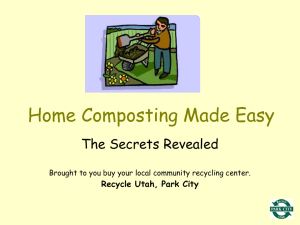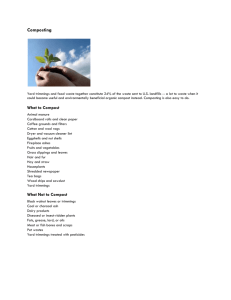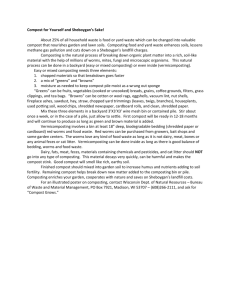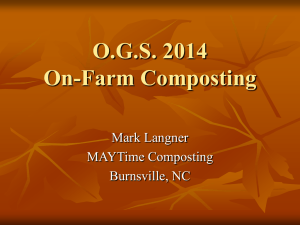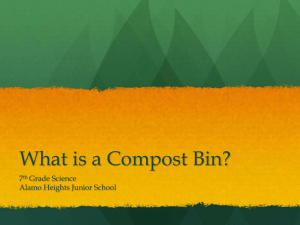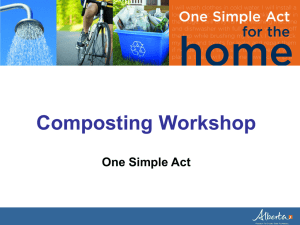Mulching-compost
advertisement
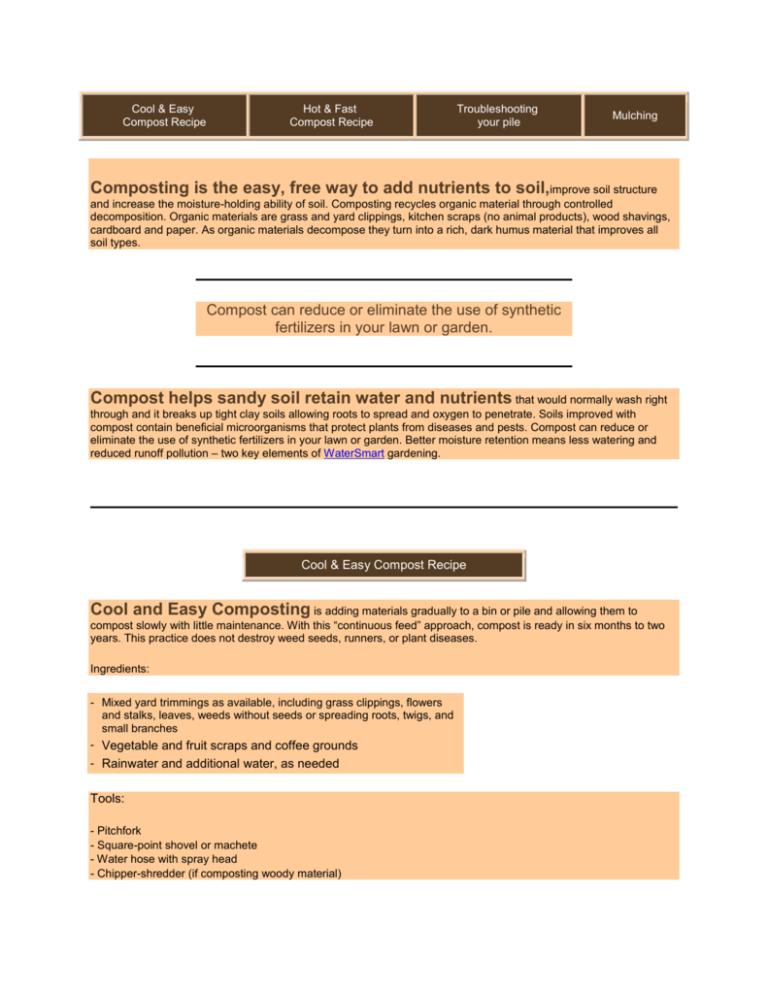
Cool & Easy Compost Recipe Hot & Fast Compost Recipe Troubleshooting your pile Mulching Composting is the easy, free way to add nutrients to soil,improve soil structure and increase the moisture-holding ability of soil. Composting recycles organic material through controlled decomposition. Organic materials are grass and yard clippings, kitchen scraps (no animal products), wood shavings, cardboard and paper. As organic materials decompose they turn into a rich, dark humus material that improves all soil types. Compost can reduce or eliminate the use of synthetic fertilizers in your lawn or garden. Compost helps sandy soil retain water and nutrients that would normally wash right through and it breaks up tight clay soils allowing roots to spread and oxygen to penetrate. Soils improved with compost contain beneficial microorganisms that protect plants from diseases and pests. Compost can reduce or eliminate the use of synthetic fertilizers in your lawn or garden. Better moisture retention means less watering and reduced runoff pollution – two key elements of WaterSmart gardening. Cool & Easy Compost Recipe Cool and Easy Composting is adding materials gradually to a bin or pile and allowing them to compost slowly with little maintenance. With this “continuous feed” approach, compost is ready in six months to two years. This practice does not destroy weed seeds, runners, or plant diseases. Ingredients: - Mixed yard trimmings as available, including grass clippings, flowers and stalks, leaves, weeds without seeds or spreading roots, twigs, and small branches - Vegetable and fruit scraps and coffee grounds - Rainwater and additional water, as needed Tools: - Pitchfork - Square-point shovel or machete - Water hose with spray head - Chipper-shredder (if composting woody material) - Compost bin (optional) - Tarp, burlap, or black plastic cover (optional) Directions: 1. 2. 3. 4. 5. 6. 7. Set compost bin or pile where water does not puddle when it rains, preferably in a shaded spot. Put yard trimmings in bin or pile as they are collected. Chop or shred woody trimmings. When adding grass clippings and green garden wastes to the compost pile, mix them into the leaves and other yard materials already in the pile. Bury kitchen scraps under 10 inches of yard trimmings or finished compost. Moisten dry materials as they are added. Optional: Cover top of compost with tarp or sheet plastic to keep it moist. When material at the bottom looks like dark, rich soil, you have compost. When convenient, move the undecomposed materials into a new pile or bin, and harvest and use the compost. Hot & Fast Compost Recipe Hot & Fast Compost Recipe Hot and Fast Composting is building and actively mixing a pile to produce disease-killing temperatures and can yield finished compost within a month. A minimum “batch” is enough to fill a plastic bin or build a pile at least 3 feet high and 3 feet in diameter. This practice destroys most plant diseases, weeds, and weed seeds. Ingredients: - Three to 4 or more wheelbarrows of “green” yard materials – such as grass clippings and garden debris - Three to 4 or more wheelbarrows of “brown” materials –such as leaves, dry weeds, brush, and woody prunings - Vegetables and fruit scraps and coffee grounds (as available) - Water Tools: - Pitchfork - Square-point shovel or machete (optional) - Rotary lawnmower or chipper-shredder (when composting woody material or dry leaves) - Water hose with spray head - Compost bin (optional) - Tarp, burlap, or black plastic for covering the pile and/or mixing materials (optional) - Compost thermometer (optional) Directions: 1. 2. 3. 4. Pick a 4-foot by 8-foot area where water does not puddle when it rains, preferably a shaded spot. Cover half of the 4-foot by 8-foot area with a 6-inch layer of “brown” materials. Add a 3-inch layer of fresh “green” materials, and add a dash of soil or finished compost. Mix this layer lightly into the layer below it with a hoe or hand cultivator. 5. 6. 7. 8. Top with a 3-inch layer of “brown” materials and add water until it is moist. Repeat steps four through six until the pile is a least 3 feet high. Note: The pile should be completely covered with 4 inches or more of brown materials. Food materials should be mixed in and buried deep in the pile. Turn the pile over every one to two weeks with a pitchfork or shovel until the pile does not re-heat much after turning. With each turning, move dry materials from the edges into the middle of the new pile, and add water as needed. Let the pile cure for two weeks before using. Troubleshooting your pile Symptoms Possible Causes Damp and warm only in Pile too small, built too middle of pile gradually, or cold weather Pile not heating up at all 1. 2. 3. 4. 5. Not enough nitrogen Not enough oxygen Not moist enough Pile too small, build too gradually, or cold weather Compost finished Possible Solutions Form pile at least 3 feet high and wide, Cover with tarp. Put in covered bin. Or allow to compost “cold” 1. 2. 3. 4. 5. Mix in fresh grass clippings, manure, or food scraps. Turn or fluff the pile, especially where it is smelly or matted. Turn the pile, wetting as you turn to consistency of damp sponge. Form pile as least 3 feet high and wide. Cover with tarp. Put in covered bin. Or allow to compost “cold and slow”. If dark and crumbly, smells earthy (not moldy or foul) – use it! Matted, undecomposed Compaction, poor aeration, or Avoid thick layers or leaves, grass, or paper. Break leaves or grass lack of moisture up layers with garden fork, then wet and re-mix the clippings pile. Shred materials. Odor like rancid butter, vinegar, or rotten eggs Not enough oxygen, too wet or compacted Turn pile, fluffing materials to aerate them. Add coarse dry materials like leaves as needed to soak up excess moisture. If odor is intense, possibly cover with layer of newspapers and/or coarse dry materials and allow pile to mellow before turning. Odor like ammonia Not enough carbon Add “brown” materials and aerate. If odor is intense, possibly cover and allow pile to mellow before turning. Attracting rats, Inappropriate materials (meat, Dispose of meat and oil. Use a rodent-resistant bin. raccoons, dogs, flies, or oil, bones, etc.) or food too Bury kitchen scraps 8 to 12 inches deep in the pile. other pests close to surface Attracting various insects, centipedes, slugs, etc. Normal composting If garden pests are identified in pile, use traps or barriers between pile and garden. Infested with fire ants Too dry, not hot enough, or food too close to surface Drench ant mounds with compost tea sweetened with feed-grade molasses. Broadcast low-toxicity fire ant bait for major infestations. Carefully rebuild pile to proper conditions, wetting thoroughly. Mulching Mulch is a material spread on top of the ground to benefit soil and plant health, and make landscape maintenance easier. Wood chips, leaves, grass clippings, wood shavings, and compost all make good mulches. Mulching Benefits: Prevents soil compaction and erosion Suppresses weeds Captures and retains soil moisture Protects roots from the sun’s heat Protects plant crowns from winter cold Protects and stimulates microbial activity in the soil Adds nutrients to the soil as they break down Make the Best Use of Mulch Covers Mulch all areas that are not in grass or thick ground cover. Trees and shrubs benefit from mulch spread at least as far as their outermost branches (the “dripline”). To prevent diseases and pest infestation, avoid piling mulch against tree trunks. Use a layer of coarse mulch 3 or more inches in depth for weed control. When converting grassy areas to mulch, smother the grass with a thick layer of cardboard or newspapers rather than kill it with chemicals. Some hardy grasses much be rooted out for successful removal. Blanket perennials with several inches of shredded leaves or whole pine needles to protect then from winter cold. Use long-lasting mulches (wood chips, shavings, evergreen needles) for trees and shrubs. Spread mulches under annuals after they are well established (4 to 6 inches tall). Water the ground thoroughly before and after applying a mulch cover. Never rely on a rainstorm to water in your mulches. In many cases, the rain will fall too heavily and quickly, and a fair amount of your mulch may run off into the storm drain and local creeks. Never mulch with diseased or insect-infested yard trimmings.


